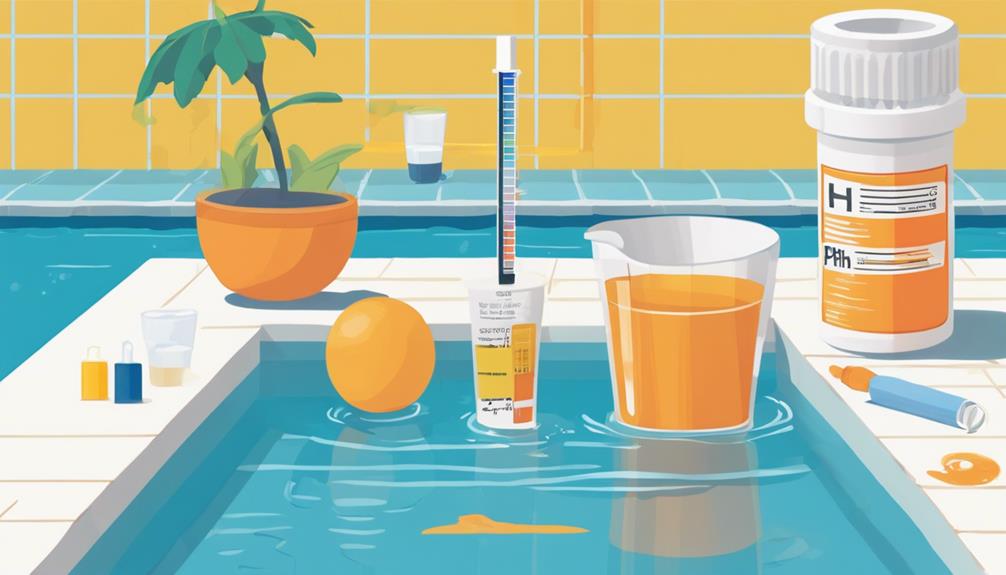To balance your pool’s pH, you need to maintain a delicate balance between acidity and basicity. The ideal pH range is 7.2-7.8, with 7.4-7.6 being the sweet spot for swimmer comfort and equipment longevity. Test your pool’s pH daily using test strips or kits, and adjust accordingly. If your pH is too high or low, you can use soda ash or muriatic acid to raise or lower it. Remember, total alkalinity plays a vital role in stabilizing pH levels, so verify it’s within the 80-120 ppm range. By following these steps, you’ll be well on your way to achieving a balanced and healthy pool ecosystem, and there’s more to explore to maintain your pool water remains perfect for swimmers.
Key Takeaways
- Test pH levels daily using pH test strips or pool test kits to ensure accurate readings and prevent fluctuations.
- Maintain ideal pH ranges between 7.2 and 7.8 for swimmer comfort, equipment longevity, and pool surface protection.
- Use soda ash to raise pH levels, and muriatic acid or sodium bisulfate to lower pH levels, following instructions carefully.
- Regularly test and adjust total alkalinity levels between 80-120 ppm to stabilize pH levels and prevent sudden changes.
- Make adjustments to both pH and total alkalinity levels to achieve a balanced and stable pool water chemistry.
Understanding Pool Ph Basics
Mastering the fundamentals of pool pH is essential to maintaining a safe and enjoyable swimming experience, as it directly impacts the comfort of swimmers and the longevity of pool equipment. You need to understand that pool pH measures the acidity or basicity of the water, with 7 being neutral. The ideal pH range for your pool is between 7.2 and 7.8, with the ideal level being between 7.4 and 7.6 for swimmer comfort and equipment longevity.
As you fill your pool with water, you’re starting with a pH level that’s not necessarily ideal. Tap or hose water typically has a pH level of 6.5-8.5, which can be too acidic or alkaline for your pool. Added chemicals can raise or lower the pool’s pH, making it more acidic or alkaline. To achieve balanced pool water, you’ll need to test and adjust the pH level regularly. Remember, pH levels that are too high or too low can cause eye irritation, skin irritation, corrosion of equipment, and damage to pool surfaces. By understanding these basics, you’ll be well on your way to maintaining a safe and enjoyable swimming environment.
Testing and Interpreting Ph Levels
To guarantee your pool water remains safe and enjoyable, you need to regularly test and interpret pH levels to maintain the ideal range. Daily testing is vital, as pH levels can fluctuate constantly due to evaporation, swimmer activity, and added chemicals. You can use a pH test strip or pool test kit to check the pH level of your pool water.
| pH Level | Water Condition |
|---|---|
| Below 7.2 | Acidic (irritating to eyes and skin) |
| 7.2-7.8 | Ideal range (comfortable for swimmers, safe for equipment) |
| Above 7.8 | Alkaline (irritating to eyes and skin, damaging to equipment) |
When interpreting pH levels, a reading below 7.2 indicates acidic water, while a reading above 7.8 indicates alkaline water. Both conditions can cause eye and skin irritation and damage to pool equipment. To maintain a pH balance and prevent these problems, you must test pH levels regularly. By doing so, you’ll confirm your pool water remains safe, comfortable, and enjoyable for swimmers.
Note: The alternatives used are vital (crucial), confirm (ensure), and must (it’s essential to).
Causes of Ph Imbalance

When you’re trying to balance the pH in your swimming pool, you’ll need to examine how human error factors, such as incorrect chemical dosage or inadequate testing, might be affecting your pool’s pH levels. Additionally, you should also investigate chemical contamination sources and environmental influences that could be contributing to the imbalance.
Human Error Factors
Human error plays a significant role in pH imbalance, and recognizing that your actions, or lack thereof, can throw your pool’s chemistry out of whack is crucial. As a pool owner, you have a significant impact on maintaining the balance of your pool’s pH levels. However, it’s easy to make mistakes that can lead to pH imbalance.
- Inadequate testing and monitoring: Not regularly testing your pool’s pH levels can lead to pH imbalance. You should regularly test your pool water to verify the pH levels are within the ideal range.
- Failure to adjust for weather changes: Weather changes like heavy rainfall or intense sunlight can affect your pool’s chemistry. You need to adjust your pool’s pH levels accordingly to maintain balance.
- Inexperienced pool ownership: If you’re new to pool ownership, you might not understand the importance of pH balance, leading to neglect of regular testing and maintenance.
- Incorrect dosage of pH-adjusting chemicals: Over- or under-dosage of chemicals like muriatic acid or soda ash can cause pH imbalance. Make sure to follow the instructions carefully when adding these chemicals to your pool.
Chemical Contamination Sources
Your pool’s pH levels can be compromised by various chemical contaminants that find their way into the water, either intentionally or unintentionally. As a pool owner, being aware of these sources is vital to maintain ideal pH levels. One common contaminant is muriatic acid, which can lower pH levels when added in excess. On the other hand, sodium bicarbonate (baking soda) can increase pH levels if not used correctly. Improper use of chlorine tablets or granules can also affect pH levels, as they contain acidic components like cyanuric acid. Additionally, sodium carbonate (soda ash) or Dry Acid can alter pH levels if not used in the right proportions. Calcium hardness, which is necessary for pool water balance, can also influence pH levels if not maintained within the recommended range. To avoid pH imbalances, following proper chemical application procedures and regularly testing your pool water for pH levels, chlorine levels, and other parameters is imperative. By doing so, you’ll be able to identify and address chemical contamination sources, ensuring your pool water remains safe and healthy for swimmers.
Environmental Influences
Rainfall, wind, and sunlight can all disrupt your pool’s pH balance, introducing variables that demand attention to maintain ideal water chemistry. As a pool owner, it’s essential to understand how environmental influences can impact your pool’s pH level. Here are some key factors to consider:
- Rainfall: Acidic rain can lower your pool’s pH level, while alkaline rain can raise it. You’ll need to monitor your pool’s pH after heavy rainfall to ensure it remains balanced.
- Wind: Wind can introduce debris and contaminants into your pool, affecting its pH balance. Regularly skimming and vacuuming your pool can help mitigate this issue.
- Sunlight: Sunlight can cause your pool’s pH level to rise, especially if you’re using chlorine or bromine sanitizers. Be prepared to adjust your pH levels accordingly.
- Environmental Soda Ash: If you live in an area with high levels of soda ash in the soil or water, it can affect your pool’s pH balance. You may need to use specialized products to counteract this influence.
Raising Ph With Basic Chemicals
To raise the pH level in your swimming pool, you can effectively utilize basic chemicals, such as soda ash and sodium bicarbonate, which are commonly employed to neutralize acidic conditions. When your pool water‘s pH is too low, adding these basic chemicals can help balance your pool water. Soda ash, also known as sodium carbonate, is a popular choice to raise pH levels. To achieve a 0.1-0.2 unit increase, add 1-2 pounds of soda ash per 10,000 gallons of water. Alternatively, aeration through jets, fountains, or waterfalls can also help raise pH by driving carbonic acid out of the solution, although this method may take longer. Sodium bicarbonate is another option, although it’s less effective than soda ash and may require larger quantities. When adding these chemicals, broadcast them evenly across the pool surface to prevent clouding or streaking. After adding the chemicals, retest the pool water to verify the pH level has reached the desired range and make any necessary adjustments. By using these basic chemicals correctly, you’ll be able to raise the pH level in your swimming pool and achieve a balanced, safe, and healthy pool environment.
Lowering Ph With Acidic Substances

When you need to lower your pool’s pH level, you’ll want to turn to acidic substances, which can effectively counterbalance excessive alkalinity and restore a healthy pool environment.
To achieve this, you can use the following pH-lowering agents:
- Muriatic acid (HCl): A widely available and effective option, but handle with care as it’s hazardous. Add it slowly to the pool water with the pump running to avoid sudden pH changes.
- Sodium bisulfate (NaHSO4): A popular alternative to muriatic acid, available in granules or puck form, which reduces alkalinity.
- Carbon dioxide (CO2): A gradual pH-lowering option that increases alkalinity, often used in combination with other acidic substances.
- Test and adjust: Frequently test the water to avoid over-correction, which can lead to acidic pool water and damage to the pool and its equipment.
Maintaining Optimal Ph Ranges
You’ll want to target a pH range between 7.2 and 7.8 to guarantee your pool water remains comfortable for swimmers and protects the pool’s surfaces and equipment from damage. Maintaining a healthy pH range is vital to keeping your pool water balanced and healthy. A pH level outside this range can lead to eye irritation, skin problems, and even damage to your pool’s surfaces and equipment. To achieve a proper pH balance, you’ll need to regularly test your pool water and make adjustments as needed. If your pool’s pH level is too high, you’ll need to lower it with acidic substances. Conversely, if it’s too low, you’ll need to raise it with alkaline substances. Striking a balance is vital, as fluctuating pH levels can cause chaos in your pool’s ecosystem. By maintaining a stable pH balance, you’ll be able to enjoy a comfortable and safe swimming experience while also extending the lifespan of your pool’s surfaces and equipment. Remember, regular testing and adjustments are key to keeping your pool water balanced and healthy.
Ph and Total Alkalinity Connection
As you work to maintain ideal pH ranges in your pool, understanding the vital connection between pH and total alkalinity is key. You’ll find that total alkalinity plays a vital role in stabilizing pH levels, preventing sudden changes in acidity or basicity that can disrupt the swimming environment. By grasping this connection, you’ll be better equipped to prevent pH drift and maintain a stable, comfortable pool experience.
Ph Level Stability
Maintaining ideal levels of total alkalinity (TA) is essential to stabilizing your pool’s pH, as even a slight variation in TA can substantially impact pH levels. You need to understand that TA acts as a buffer to stabilize pH levels, and an ideal TA range of 80-120 parts per million (ppm) is vital to maintain pH stability.
- A 10-20 ppm change in TA can result in a 0.1-0.2 pH unit change, highlighting the importance of maintaining suitable TA levels to achieve pH stability.
- Regular testing and adjustment of both pH and TA levels are essential to maintaining a stable and healthy pool environment.
- When TA is too low, pH levels can fluctuate rapidly, making it difficult to maintain a stable pH.
- High TA levels can make it difficult to adjust pH, leading to pH instability.
Alkalinity’s Ph Buffering
By understanding the crucial role Total Alkalinity plays in buffering pH levels, you can better appreciate the delicate balance between these two essential parameters in your swimming pool. Total Alkalinity (TA) acts as a pH buffer, neutralizing sudden changes in acidity or basicity to maintain a stable pH level. The ideal TA range is between 80-120 parts per million (ppm), allowing for a stable pH level and preventing sudden pH swings. If the TA level is too low, the pH level can fluctuate wildly, making it difficult to maintain a stable pH level. Conversely, high TA levels can make it difficult to adjust the pH level. A TA level of 100 ppm can absorb a pH change of 0.2 units, making it an ideal level for maintaining a stable pH level. Regularly testing and adjusting TA levels helps maintain a stable pH level, ensuring the sanitizer is effective and the pool water is safe and comfortable for swimmers. By maintaining the ideal TA range, you can minimize pH swings and create a more stable pool environment.
Ph Drift Prevention
You can prevent pH drift by understanding the critical connection between pH and Total Alkalinity, which allows you to make targeted adjustments to maintain a stable and balanced pool water chemistry.
When you grasp this connection, you’ll realize that Total Alkalinity (TA) acts as a buffer to stabilize pH levels. Maintaining a proper TA level of 80-120 ppm helps to prevent pH drift and facilitates that pH adjustments are more effective.
- Low TA levels lead to rapid pH fluctuations, making it difficult to maintain a stable pH level.
- High TA levels can cause pH levels to become ‘locked in’ at an undesirable level, making adjustments challenging.
- Regular testing of both pH and TA levels is necessary to prevent pH drift.
- Adjustments should be made to both pH and TA levels to achieve a stable and balanced pool water chemistry, thereby maintaining a consistent and optimal environment.
Common Ph Balancing Mistakes
What common pitfalls should you watch out for when balancing pH in your swimming pool to avoid costly mistakes and provide a safe, enjoyable swimming experience? Failing to test pH levels regularly can lead to sudden and drastic changes in pool water chemistry, causing skin irritation to swimmers and damage to equipment. Don’t make the mistake of adjusting pH levels too quickly, as this can cause shocks to the pool ecosystem, leading to cloudy water, algae growth, and equipment corrosion. Over-reliance on pH increasers or decreasers can also lead to over-correction, causing a pH swing that’s detrimental to pool water quality. Additionally, neglecting other chemical factors, such as total alkalinity and calcium hardness, can lead to an incomplete understanding of pH balancing and result in ineffective adjustments. Finally, failing to maintain a consistent sanitizer level, such as chlorine, can affect the pH balance of the pool water, leading to an imbalance that compromises the health and safety of swimmers. By being aware of these common mistakes, you can avoid them and guarantee your pool water is always safe and enjoyable.
Frequently Asked Questions
In What Order Should I Balance My Pool Chemicals?
When balancing your pool chemicals, you should follow a specific chemical sequence: Total Alkalinity, pH, Calcium Hardness, Stabilizer, and Chlorine, considering pool priorities, balanced levels, and additive order to minimize chemical interactions and guarantee accurate pool testing results.
How Long Does It Take for Ph Balance to Go Back to Normal in Pool?
You’ll wait anywhere from 30 minutes to several hours for pool recovery, depending on the time frame of pH fluctuation, chemical reaction, water circulation, filter efficiency, weather impact, and human error, so test frequently to maintain proper balance.
Should You Fix Ph or Alkalinity First?
When adjusting your pool’s chemistry, you should fix alkalinity first to prevent pH fluctuation and alkalinity spikes, as it’s a buffer that stabilizes pH, ensuring chemical reactions occur smoothly and water hardness is balanced, ultimately achieving pH stability.
Should You Balance Ph or Chlorine First?
When adjusting your pool’s chemistry, you should balance the pH first, as it’s the priority, before adding chlorine to avoid chlorine shock; acid addition or base application affect the sanitizing sequence, stabilizer impact, and oxidation rate, ensuring a chemical reaction that maintains ideal water clarity.
Conclusion
You’ve now mastered the art of balancing pH in your swimming pool. By following these steps, you’ve guaranteed a safe and healthy environment for swimmers. Remember to regularly test and adjust pH levels, as even slight imbalances can lead to eye irritation, skin problems, and damage to pool equipment. Stay vigilant and maintain ideal pH ranges to enjoy a sparkling, trouble-free pool all season long.

I’m Max, the founder and chief pool enthusiast behind Pool Pro Tips. As a passionate pool owner and cleaning expert, I created this website to share my knowledge and experience with you, helping you to keep your pool sparkling clean and safe for years to come.

